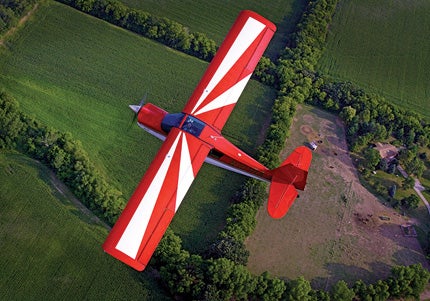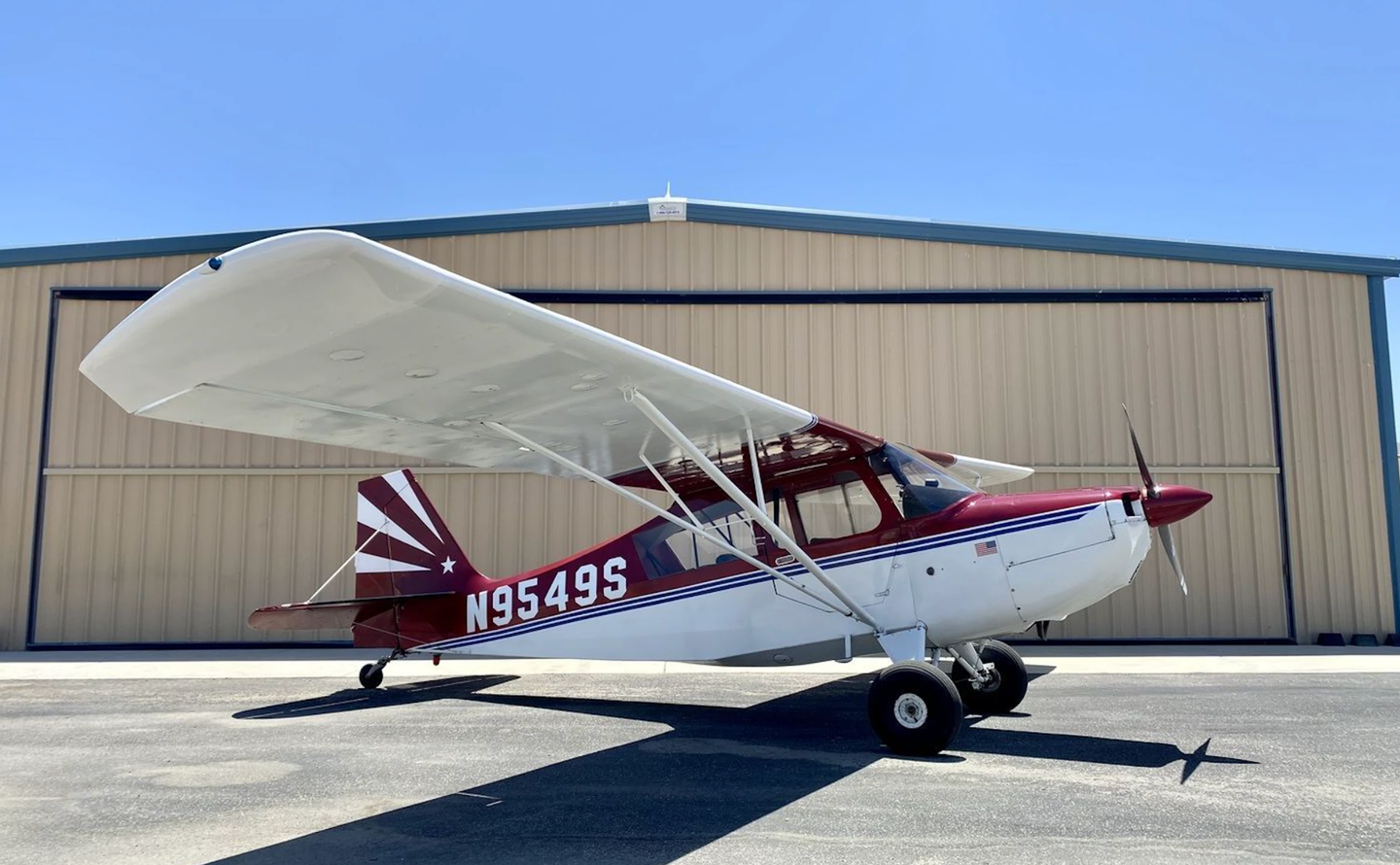8GCBC Scout: Up In Flames
The Scout Aims for a Firefight
|
I was standing beside the runway at Fox River Airport in Rochester, Wis., home airport to American Champion Aircraft (www.amerchampionaircraft.com), to see the company's stalwart 8GCBC Scout do its Elvis impersonation---as in Elvis the famous firefighting S-64 Aircrane water bomber. A call on a handheld confirmed we were in position. From the north, Jerry Mehlhaff Sr., the company's owner and president, came boring in on the centerline in N125WB, the prototype Scout "Water Bomber," dropping to about 150 feet. Just past the threshold, he released 100 gallons of water from its belly. The 800 pounds of liquid hit the runway with a loud slap, soaking an area about the size of a football field.
Can 100 gallons make a splash in aerial firefighting, where blazes can cover tens of thousands of acres? One is tempted to tell the trusty Scout, "Don't quit your day job; no shame in simply being one of the world's premier bush planes." Despite the existence of such big bombers as Elvis and Evergreen International's 747-200 Supertanker, back on the ground, Jerry Sr. made a case for using light aircraft as first responders "so they can get the fire when it starts, when it's five acres or 10, not 5,000 acres or to the point when you need a 747 to try to slow it down."
Inside the company's offices, on the back of a hangar and across from American Champion's three production buildings, Jerry Sr. told me, "The intent is to have airplanes close to the fire, and have them fly in groups of five or six. If there's no airport nearby, the state patrol can block off 3,000 feet of highway, bring a tanker truck in, fill the airplane in less than two minutes. Every airplane could make five or six drops an hour."
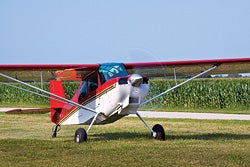 |
The Scout Water Bomber was conceived by Steve Green, a design engineer and former race-car driver from Canton, Ohio, who had been developing a light firefighting aircraft when he came across a Scout. "I said, ’This thing has great flight characteristics. This actually could be the platform,'" Green recounted. He contacted Jerry Sr., went to the factory, talked to the staff engineers, "and the next thing I knew, he built this aircraft, and it is exceptional."
The Scout's potential as a firefighter aside, the two-place, tandem taildragger already has earned its props in more than 35 years of service: It's prized by private owners, commercial operators and public agencies alike as a rugged, land-anywhere, STOL workhorse. The basic aircraft has changed little during that time, but a variety of improvements, upgrades and options make today's Scout far more user-friendly and capable than when it debuted in 1974. Its continued popularity is a testament to both the original design and the current management of this family-owned enterprise. Jerry Sr.'s former wife, Charlene, is the company's vice president; their son, Jerry Jr., an aerospace engineer and FAA-certified DER (designated engineering representative), is the company's head of engineering. And with five aircraft models in production in addition to the Scout, certification of the Water Bomber is just one item on the company's to-do list.
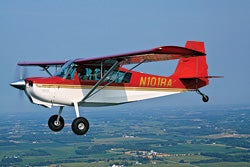 |
"You're never stuck doing the same project over and over again," said Jerry Jr. about life at American Champion.
Their airplanes come from good stock. The Scout and other American Champion aircraft all descend from the classic 7AC Aeronca Champion (Champ), introduced by the Aeronca Aircraft Corp. of Middletown, Ohio, in 1945. Champion Aircraft (no relation to American Champion Aircraft) bought the Champ design in 1954, three years after production ceased, and from the Champ, derived the aerobatic 7ECA Citabria (which is "airbatic" spelled backward). In 1970, Bellanca Aircraft Corp. acquired Champion Aircraft and subsequently introduced two new models based on the Citabria: the 8KCAB Decathlon and, in 1974, the 8GCBC Scout. (The alphanumeric model designations defy simple explanation, or even understanding. "I don't know how they came up with KCAB," Jerry Sr. said during a discourse on model taxonomy. "It's so confusing.") Bellanca ended production in 1980, and the line went through a series of owners before Jerry Sr. bought the rights in 1988 and resumed production in 1990 under the American Champion Aircraft banner.
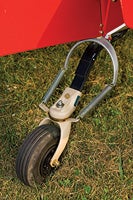 The 8GCBC's all-aluminum frame yields improved strength, performance and longevity. |
I've spent hours of Scout time over rugged Western landscapes, landing on buttes, prairies and dry riverbeds. Flying a wildlife population survey in the Badlands of North Dakota, every bowl and draw in the survey area had to be scoured for deer, mountain goats and stray bison. That meant lots of yanking and banking in slow flight very close to the deck, as well as quick climbs over sharply rising terrain. A Scout is one of the few planes you can trust with that kind of flying.
The Scout Water Bomber will be a far different ride. The back-seat area is taken up by a formed plastic bladder for water and fire retardant. Gross weight will be 2,600 pounds, 450 pounds above its utility-category max weight. The bomber also has a flying tail that's 25% larger than the certified Scout's, to compensate for the aft CG loading. Though cutting edge in its own way, it does not represent the contemporary utility-category Scout. Fortunately, a brand-new production 8GCBC was in the hangar in front of the offices, awaiting delivery to a dealer.
From the outside, N101RA looks like a Scout of any vintage, with its squared-off front end, the straight lines of the sides, belly and vertical fin, and the simple spring gear struts. It stands on aluminum legs, which became standard in '06, replacing the original steel gear. The new struts save 35 pounds and incorporate internal brake lines. Today's Scouts also can be fitted with Alaskan Bushwheel's Tundra Tires of up to 36 inches, which open soggier, rougher ground to the Scout, and increase the wing's angle of attack during takeoff and landing, boosting STOL performance.
The wings themselves represent the biggest if least visible difference between legacy Scouts and American Champion's version. Bellanca used wooden spars in the wings; American Champion's Scout has all-aluminum frames, yielding more strength, better performance and increased longevity. (Aluminum-frame wings can be retrofitted on older Scouts.)
On the fuselage aft of the cabin, a baggage door opens to a more recent improvement: an optional extended rear baggage area introduced in '07 that adds 36 inches and 30 pounds of cargo capacity.
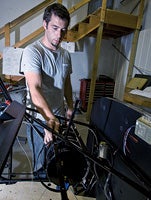 |
The Scout comes standard with a two-blade, 76-inch Hartzell propeller, but choices have grown over the years. The three-blade, 72-inch Hartzell, which provides more ground clearance, has become a popular option since it was introduced in the mid-'90s, and weight-saving two- and three-blade, wood-core, composite MT propellers were added to the list of approved props in 2003.
What most distinguishes the modern Scout from its predecessors is the panel. Mind you, Scouts have sported digital avionics since the late 1990s, and customers can order custom packages---but digital engine monitoring and glass technology have been added to the mix. In 2005, J.P. Instruments' EDM-930 became an option. From the left side of the panel, it tracks rpm and manifold pressure, fuel flow, electrical-system health and engine temperatures, and flashes alerts if parameters are exceeded. In 2008, Aspen Avionics' Evolution EFD1000 PFD was certified in the Scout, turning it into a true glass-panel platform. Among other benefits, the optional Aspen installation saves about 11 pounds over the vacuum gyro system it replaces. When all potential weight savings are taken into account, the Scout has dropped some 55 to 60 pounds of empty weight in recent years.
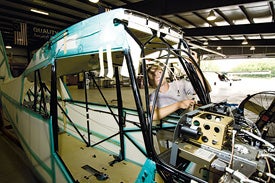 |
After taking the Scout out of the hangar, we completed its preflight. The interior is nicely appointed with carpet and fabric and vinyl sidewalls. An optional wide rear bench seat, a Bellanca-era upgrade (quickly removable for extra cargo room), adds to the comfort. The throttle, prop and mixture controls are on the bottom left side of the panel. We primed and cranked the engine, and Jerry Sr. and I taxied to runway 1.
The Scout is powered by a 180 hp, carbureted O-360 Lycoming. The carbureted engine is less expensive than a fuel injected one, and most pilots who operate Scouts on floats prefer them because of concerns about vapor lock during hot starts associated with injected engines; few things are worse for a float pilot than being adrift on the water with a flooded engine.
On the takeoff roll with two notches of flaps (15 degrees) and 2,700 rpm at full throttle, the tail came off the ground at about 40 mph; we rotated at 45 mph and were airborne by 50 mph. At a 70 mph indicated climb, the VSI bounced around 1,100 fpm, and the Aspen PFD, with its airspeed and altitude tape readouts, made quick scans of the panel more productive than darting glances at steam gauges.
We leveled at 2,000 feet MSL and powered back to 24 squared, about 75% power, and let the airspeed build up. It reached about 130 mph indicated at a 10.4 gph fuel burn. That's solid cruise performance for a STOL airplane, highlighting the wide operating envelope that has helped make it a success.
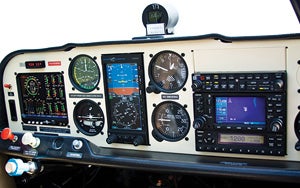 |
The checkerboard farmland of southern Wisconsin spread out in all directions below. The verdant fields made it hard to imagine a landscape covered in flames, or envision a Scout swooping in to the rescue. So I pulled the stick around as if I was flying knife-edge along a ridge, and maneuvered as if dodging towering flames to reach my drop point. But instead of demonstrating some firefighting capacity, N101RA's response simply reminded me of the Scout's nimble and fun-to-fly characteristics. Poking about the countryside, we moseyed over to Burlington Municipal Airport, a few miles southwest, and entered the pattern for runway 11. With light winds and 4,300 feet of runway, the landing was low on drama, but with three notches of flaps, the Scout demonstrated its excellent visibility over the nose on final.
After returning to Rochester, Jerry Sr. briefed me on the next upgrade for the Scout: Forward Vision's EVS-100 infrared enhanced-vision system, expected to soon be certified for installation. That will add even more capability to its bush operations and also make the Water Bomber a more effective tool. "We can pick flames out through smoke or firemen surrounded by flames," Jerry Sr. said.
As certification work continues on the aircraft, agencies in California, North Carolina and other states, eager for an effective and economical aerial firefighter, have expressed interest. The estimated operating cost is $150 per hour, including pilots' pay ($40), while even a small firefighting helicopter, noted project architect Green, "costs $2,500 to $3,000 per hour; you can operate 20 Scouts for that."
Jerry Sr. and I went flying again later that afternoon. The last landing was on turf at Rochester, between the paved runway and a cornfield. The Scout felt like it was luxuriating in its natural element as it trundled across the thick grass on rollout, rekindling my memories of alighting on rugged ground out West. And after getting reacquainted with the 8GCBC, I was sure it could handle anything asked of it, including performing as a professional Water Bomber and making people forget all about Elvis. Indeed, rather than a karaoke-caliber imitation, perhaps the aircraft could become the aerial firefighting world's latest flame.

Subscribe to Our Newsletter
Get the latest Plane & Pilot Magazine stories delivered directly to your inbox

